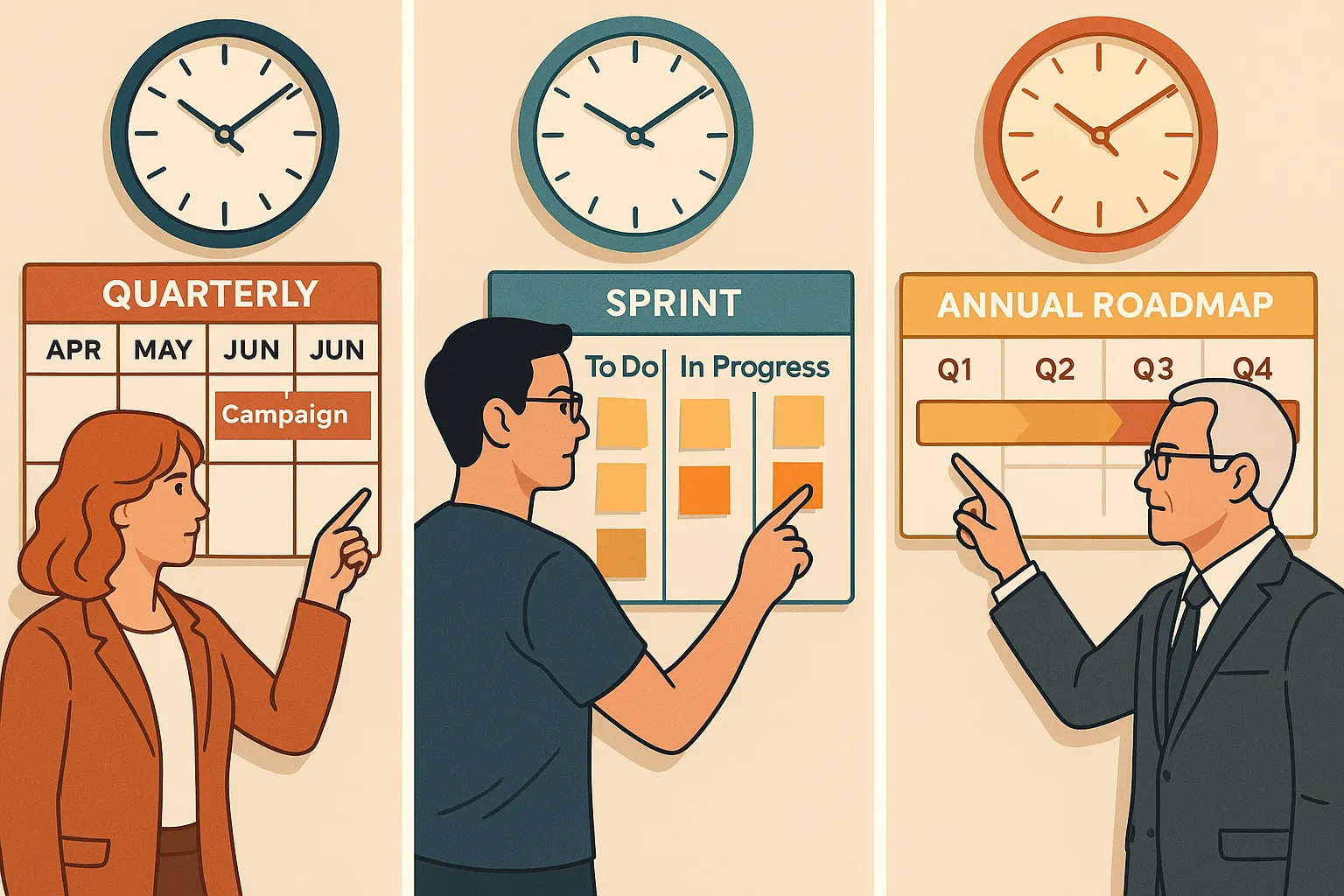Under the hood, the real tension is between the need for certainty and the pull of responsiveness. And your planning rituals? That’s the battlefield.
You can’t ship good software without a plan. But you also can’t ship if that plan turns into a prison.
So much of the drama around “agility vs process” isn’t really about methodology. It’s about control. Who gets to set the pace? Who gets stability? Whose work gets disrupted when the unexpected hits?
The problem isn’t the plan. It’s pretending the plan is reality.
Planning Across Timeframes
Not all planning modes are built for the same kind of work. Some systems need rigor. Others demand adaptability. The real skill is knowing when to switch, and recognizing that each mode reflects a different relationship to time.
Here’s the core model:
- Lagging Planning: Anchored in the past. Think compliance, safety, regulation. It’s about minimizing variation and enforcing stability.
- Reactive Planning: Operating in the now. Real-time response, iterative delivery, incident handling. You react as things unfold.
- Leading Planning: Geared toward the future. Innovation, strategy, market sensing. You’re not trying to control uncertainty. You’re learning from it early.
Strong teams blend these intentionally. You might be in lagging mode for your SOC 2 prep, reactive mode for live-site incidents, and leading mode for R&D bets, all in the same week.
The catch? These aren’t just techniques. They’re competing temporal claims. And that’s why planning conflicts escalate. Teams think they’re debating tools, but the real fight is over whose clock governs the work.
The Modes, Broken Down
- Lagging Planning: “How do we control what just happened?”
Retros, postmortems, standardization. It’s the system tightening itself. - Reactive Planning: “How do we respond to what’s unfolding?”
Agile’s comfort zone. Feedback loops, flexible priorities, realignment as needed. - Leading Planning: “How do we prepare for what’s emerging?”
Often underfunded and deprioritized. Found in strategy pods and innovation labs. The goal is positioning before the market even notices the shift.
Most orgs live in lagging mode because it feels safe. Some evolve into reactive. Very few make consistent room for leading. But without it, you’re always catching up, never shaping the future.
Attention Economics: Planning as Portfolio Management
Planning isn’t free. Every meeting, ritual, and deck competes for a limited budget: attention.
If you start treating planning like a portfolio, the question becomes: what’s the ROI on this attention?
A 90-minute planning session that shifts nothing? Low return.
A 15-minute sync that clears a blocker for three teams? High yield.
The problem shows up when teams try to run all three modes. lagging, reactive, and leading. Across every project, every week. You end up cognitively bankrupt, spread across too many timeframes, with no space to think.
Great planning is less about frameworks, more about ruthless attention allocation. Some rituals need to go, they’re too expensive for what they deliver
Temporal Sovereignty: The Hidden Battle
This is the conflict most orgs don’t name.
Different teams operate on different clocks:
- Sales moves in quarters.
- Engineering thinks in sprints.
- Execs steer by fiscal years or multi-year roadmaps.
Each function defends its own temporal sovereignty, its sense of what matters when.
The real breakdown comes from temporal colonialism. When one team imposes its time model on another.
- Marketing pushes quarterly deadlines that ignore engineering velocity.
- Product enforces daily standups in a domain that would benefit from slower cadence.
- Leadership promises multi-year commitments without short-cycle review gates.
These are sovereignty violations, not simple misalignments
The solution isn’t to force uniformity. It’s temporal translation, the art of coordinating across different clocks without collapsing them into one.
That might look like:
- A rolling roadmap that maps sprints to quarterly GTM milestones.
- OKRs that ladder from vision to sprint-level tasks, then roll back up in monthly reviews.
- Rituals that hold space for different planning cadences, but sync at shared decision points.
Done well, this builds coherence without flattening nuance.
Practical Moves to Make It Real
If you want to plan across time without breaking your team’s brain, you need lightweight, high-signal rituals.
Try these:
- Assumption Audits
Once a month, ask: “What bets are we making?” (Market behavior, resourcing, tech decisions.) “What if we’re wrong?” Then re-risk accordingly. - Weak Signal Scanning
If three customers mention the same strange edge case, flag it. That might be a canary in the coal mine, not just noise. - Scenario Stress-Testing
Pick a big initiative and ask: “If this failed, what’s the most likely reason?” Now solve for that before it bites you.
These rituals focus on signal sensitivity, not speed. They help your team notice faster, not just move faster.
Pair that with temporal translation, and you’ve got a system that aligns strategy with execution without burning everyone out.
Selling Anticipation, Not Just Agility
Here’s the part most agile evangelists miss:
Some stakeholders don’t want agility. They want predictability, even if it’s fake.
It’s not malice. It’s risk management.
That’s why anticipation is the better sell. The advantage is seeing sooner, not just reacting faster.
You can say:
“We can’t guarantee the Q4 release will look exactly like this. But our delivery cadence means we’ll know by mid-Q3 if we need to pivot, not two weeks before launch.”
Tactically:
- Use shorter commitment windows (2–4 weeks) instead of pretending to lock in quarters.
- Build credibility through consistent delivery.
- Forecast, don’t promise, and flag material changes early.
You can’t eliminate uncertainty, but you can make it survivable.
The Real Goal
If your process can’t absorb new information. That’s performance, not planning.
Burnout-inducing agility is reactive chaos, not responsiveness
The sweet spot?
A system that moves with purpose, even when the ground shifts underneath you.
Not frozen. Not flailing. Just forward, with eyes open.
